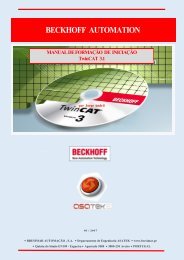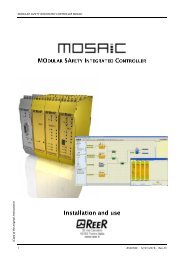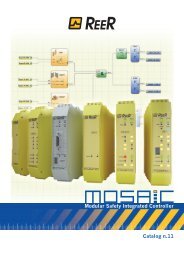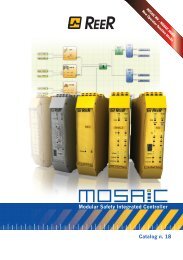BB ELECTRONICS CATALOG (2010)
Catalog from B&B Electronis (2010)
Catalog from B&B Electronis (2010)
You also want an ePaper? Increase the reach of your titles
YUMPU automatically turns print PDFs into web optimized ePapers that Google loves.
Serial cards<br />
An Introduction to PCI Technology<br />
Serial<br />
What are universal PCI cards?<br />
In the days of yore, the PCI bus used 5 V signaling on the PCI<br />
connector. Some PCI buses, including many of today’s newest<br />
PC’s use 3.3 V signaling. A keyed notch in the card prevents it<br />
from being plugged into the wrong version of the bus. If you<br />
buy a 5 V PCI card, it won’t fit into a 3.3 V bus, and a 3.3 V<br />
PCI card won’t fit into a 5 V bus. A situation fraught with peril<br />
for the casual customer! Not to worry, all of the PCI cards in<br />
the following pages follow the Universal PCI specification,<br />
officially termed PCI V2.3. As you might guess, Universal PCI<br />
is compatible with both 3.3 V and 5 V systems. To tell if your<br />
card is Universal PCI, look for two keyed notches in the bus<br />
connector, indicating that it will fit (and work!) in any PCI<br />
system.<br />
What about the ISA bus?<br />
Need serial cards for the ISA bus? We’re happy to say that B&B Electronics continues to stock and support ISA cards (to be honest,<br />
some of us even feel an emotional attachment to these cards). To see our full line of multi-interface and isolated ISA cards click<br />
over to www.bb-elec.com<br />
Multi-interface PCI (page 34)<br />
You’ll find that B&B Electronics’ MIport family of PCI cards has the flexibility to fit any<br />
system. Two, four and eight port versions feature RS-232, RS-422 and RS-485 capability!<br />
Optically isolated multi-interface PCI (page 34)<br />
These optically isolated members of the MIport family of PCI cards are robust enough for the<br />
toughest and most mission-critical environments. One, two and four port versions offer the<br />
flexibility of RS-232, RS-422 and RS-485!<br />
PCMCIA (page 35)<br />
Add serial or parallel ports to your laptop for mobile and field service applications. One, two<br />
and four ports are available in both RS-232 and RS-422/485 versions. Rugged versions<br />
featuring a permanently attached cable are also available.<br />
ExpressCards (page 35)<br />
ExpressCards add 1 to 2 high-speed serial ports (RS-232 or RS-422/485) or 1 parallel port to<br />
notebooks and other mobile devices. High throughput and low latency is comparable to<br />
native, built-in COM ports.<br />
Technician’s Notebook<br />
Janet: Isolation zones explained<br />
Isolated serial card design requires attention to three things. Special optocouplers isolate the serial<br />
signals from the PCI bus. Unique isolated DC-to-DC power supplies provide power to each of the<br />
ports and give us port-to-port isolation. Finally, the<br />
circuit board uses strict spacing rules – we call these<br />
Isolation zones on the 3PCIOU2<br />
isolation zones. Surges follow the path of least<br />
resistance, and a tiny gap between traces is an easy<br />
path for surges to reach the delicate computer bus,<br />
bypassing expensive isolation components entirely.<br />
You’ll find wide isolation zones on B&B Electronics’<br />
isolated PCI cards. If you’re buying boards from<br />
someone else, hold them up to the light and check for<br />
these isolation zones, you might not be getting the<br />
protection that you’re paying for.<br />
Isolation zone<br />
Back of 3PCIOU2<br />
Converters<br />
Fiber<br />
Optics<br />
Telephone<br />
Modems<br />
Specialty<br />
Converters<br />
Splitters,<br />
Combiners,<br />
Data Taps SEL<br />
Data<br />
Switches Cards<br />
www.bb-elec.com<br />
815.433.5100<br />
33


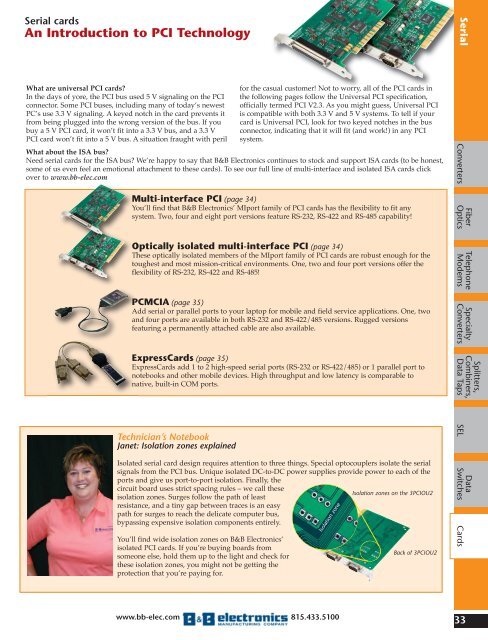

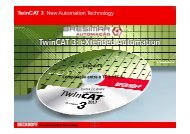
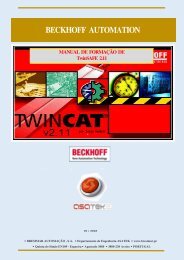
![BRESIMAR(asaTek)-Beckhoff-Livro Formação Técnica TwinCAT 2-v1.2_2009 [pt]](https://img.yumpu.com/62853104/1/190x245/bresimarasatek-beckhoff-livro-formacao-tecnica-twincat-2-v12-2009-pt.jpg?quality=85)


